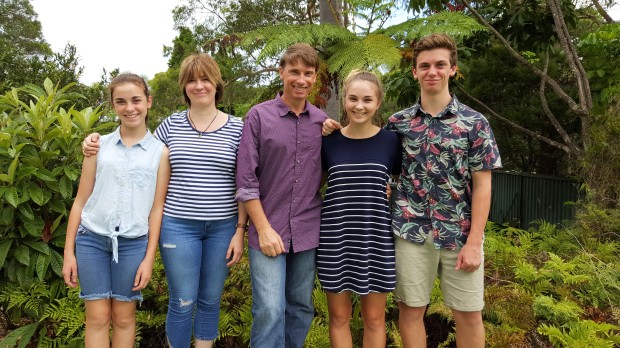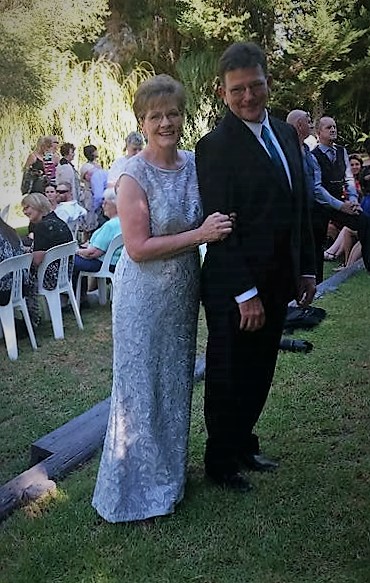
18 Dec 2015
Has being in your 40’s changed the way you ride, does it restrict what you can do, has it affected your training?
I think as I get older I’m not as flexible as the younger people, or I have to work on it more. Injuries take longer to heal, for instance I tore my calf muscle last Christmas while running too far with tight calves, have rolled a few ankles running on rough trails and a few issues with my ITB which causes a lot of pain in the knee while trying to run. But stretching and some basic exercises helps to minimize these issues. With cycling I struggle, at times, to keep up with younger riders in short sharp efforts requiring a high heart rate, but then they usually struggle to stay with me on long efforts requiring a higher level of endurance.
How has your wife Jodi and the children supported your sport?
Jodi travelled to the first few events with me but only saw me at the start and finish line with 4-6hrs to fill in between. The family came to a few local races but after several events found it difficult to fill in the hours between starting and finishing times. They were there to support me at the 8hr MTB enduro when I finished in 2nd place, each lap (10 laps) they had some food ready for me and a full water bottle to grab. The kids were excited about my position on the leader board so wouldn’t let me stop too long and gave me lots of encouragement. At times I felt like stopping for a while but Jodi and the kids wouldn’t let me, so I owe my 2nd place to them.
My son Clayton has done a few Adventure Races with me, with us both even getting a bit of TV time on the TV program ‘Sydney Weekender’ at one of our races. We both travelled to Canberra early this year for a MTB race which he enjoyed and did well in.

Glenn and Family
L to R:
Abbie, Jodie, Glenn, Brierley and Clayton
Where do you see yourself in 10 years’ time in terms of sport?
I currently race against men in their 50’s and 60’s, even getting beaten by them occasionally in local club cycling races and all the other events I do. My hope is that I will still be doing what I am now, and if I’m lucky I will be just as fast or competitive.
One goal or event on my “bucket list” is a race called XPD and it is run in Australia every 18mths. They are run all around the world by different companies. This race will be held in the Shoalhaven region on the south coast of New South Wales in November 2016 and will be the Adventure Racing World Championships. XPD is Australia’s own expedition length adventure race. Teams of four competitors from around the globe trek, mountain bike, and kayak for five to ten days in this world renowned expedition. These adventure competitors race continuously day and night, over a 700km course pushing themselves to the ultimate limits of human endurance.
5. How do you think you have benefited from participating in sport at this level?
I believe there has been many benefits since starting to run, cycle and compete in various types of races.
I have learnt a lot about myself, my body and what I can achieve, or how far I can push myself. When I started contemplating my first Adventure Race I knew I could run, ride and kayak but putting them all together and racing for about 5hrs….. I wasn’t sure I could do it. But within a few years of my first race I was doing this for 24hrs non-stop. I’ve learnt how to think in a much more positive way. It’s easy for your mind to tell you that you can’t do something or it’s too hard; it’s all about changing your mindset and thinking positively – knowing that you can do it and nothing is too hard or impossible. When things get tough and you feel like stopping or quitting instead of focusing on the finish line many miles or several hours away I set short goals for instance, getting to the next checkpoint or the next corner on a long climb. One particularly tough ride in France was a 40km climb with nearly 3000m elevation, the last 5km got steeper and was very tough. I was setting goals to reach the next km sign and from the last 2km point I just kept trying to reach the next white guide post every 100m was a challenge.
I’ve even learnt a little about the anatomy of the body, how different muscles work, how certain muscle groups work together and ways of helping to relieve sore, tight muscles through stretching or using a foam roller – which is not fun!
Participating in these sports encourages a healthier lifestyle and diet. I find I have a much higher energy level. Once or twice a year I generally take a small group of fit and healthy teenagers aged between 15 and 18 years on a 2-3 day hike in remote bushland, carrying all our own gear. The teenagers tend to be surprised that I am always waiting for them at the top of a long steep climb, smiling & ready to push on. I try to motivate them and push them along towards the end of the day when they are getting tired and their energy levels are dropping.
Before I started racing the words calories, carbohydrates and protein didn’t mean much… I just ate food. I am now much more aware of what I eat day to day. During short events of up to 6hrs energy bars and sports gels supply enough fuel for the race but races of over 12hrs require much more planning with food. Although you can survive on bars and gels eating real food is much better and easier on your stomach. My race partner used mostly bars and energy gels in our first 24hr event and regretted it, they left a bad taste in his mouth for days.
I use sandwiches, both wholemeal and white for low and high GI carbs, with fillings like banana, banana with honey, jam. I found peanut butter sandwiches don’t work as it is too dry and took me around 2km to eat it while running plus, I needed to consume more water. Pre-made vegetarian pasta or rice meals like a chickpea curry for the later stages of the race work well. Some fruit like bananas & apples are always nice; mixed dried fruits and figs also work well. The Up & Go food drinks are good. Drinking plenty of electrolyte is also important to replace salts and minerals lost during sweating, and to help prevent cramping. They also contain carbohydrates to help maintain energy levels. I always carry a few energy bars and sports gels as a backup if needed. eating enough carbs during the race and even carb loading for a few days prior to a long event can also take place. Carb loading generally involves eating quality pasta or rice meals.
I’ve learnt about glycogen (energy) stores in your body and how important it is to eat to replenish your carbohydrates during a ride of more than a few hrs. It is very unpleasant when you “hit the wall” or “bonk”, it comes on quite suddenly and is very demoralising. You might be happily cruising along at 35-40km/hr when you quickly drop to feeling totally exhausted and struggling to ride at 15km/hr. There is no choice but to stop, rest and eat something with a high sugar content. It’s then a slow tough ride home or a pick up if my wife feels sorry enough for me. After depleting your glycogen levels to this point there is no way you could ride or train again the next day. It can take up to 2 days to recover and feel reasonably good again on the bike.
This is the final part of our interview with Glenn Roy Di Salvia. I want to say a special thanks to Glenn and Jodie for agreeing to the “interview”, as it was a lot of fun to work on together.
Sources:
Lead Photo – http://www.gjwphotos.com/








You must be logged in to post a comment.